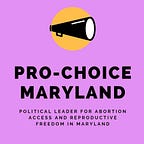Disability in Reproductive Rights Activism: A Call to Action
By: Marian Geiger
Why Center Disability?
My passion for the intersections of disability and reproductive justice comes from my academic background in feminist, queer and critical race disability studies. After learning about the history of compulsory sterilization against disabled folks and women of color, I was drawn to learn how this has left a lasting impact on reproductive rights activism. Disability standpoint is often overlooked in activist circles. Centering disability in reproductive justice activism allows us to engage in nuanced conversations around bodily autonomy, the right to have children, the right not to have children and the right to parent those children in safe and healthy environments. Reproductive justice provides a framework that remains mindful of the unique positionality of disabled folks.
Resisting a Disability and Reproductive Rights Dichotomy
Disability and reproductive rights have been placed as opposing forces in discussions around reproductive freedom. Anti-abortion activists have worked to sustain this dichotomy between disability and reproductive rights movements by developing harmful rhetoric that shames pregnant people. Selective abortion bans and restrictions often hinge upon fetal anomaly and disability, creating an abortion hierarchy that does not support disabled folks or pregnant people; “beyond undermining women’s autonomy unfairly, bans on selective abortion also worsen the stigma against people with disabilities — while doing nothing to address the practical issues they and their families face” (The Guardian, 2019).
Disability Justice as Reproductive Justice
As reproductive rights activists we must be mindful of the United States’ history of compulsory sterilization of people with disabilities and continued implicit bias. Disability justice and reproductive justice both center principles of autonomy, dignity and justice for those who have been disenfranchised (ReproAction, 2018). The movement towards reproductive justice originated from Black feminist advocacy in 1994 to center those whose experiences were excluded from the mainstream reproductive rights movement. The movement towards disability justice originated in the early 2000s following the rights-based disability activism of the 1990s. Disability justice organizing grew out of queer and POC groups to address ableism within progressive social movements. Principles of disability justice include, intersectionality, leadership of those most impacted, anti-capitalist politic, commitment to cross-movement organizing, recognizing wholeness, sustainability, commitment to cross-disability solidarity, interdependence, collective access and collective liberation. Rather than seeing these two movements as inherently separate, it is essential to consider their shared intersectional values.
Integrating Disability into Reproductive Justice Organizing
If we as reproductive justice activists do not integrate disability justice activism into our work, we risk allowing pro-life supporters, and a history of reproductive coercion dominate the conversation around disability and reproductive rights. With increased awareness of movement intersections, reproductive rights organizations are taking on the work. This includes developing stances and language related to disability, and addressing abortion hierarchy by shifting the focus to center bodily autonomy of the pregnant person. We must work to address our own implicit biases around disability, address systemic ableism, and ensure our activist spaces are inclusive for people with disabilities through accessibility and principles of universal design (The Center for Reproductive Rights, 2017).
References
Center for Reproductive Rights. (2017, March). Shifting the frame on disability rights for the U.S. reproductive rights movement. Reproductive Rights. https://reproductiverights.org/sites/default/files/documents/Disability-Briefing-Paper-FINAL.pdf
Guttmacher Institute. (2020, January). Banning abortions in cases of race or sex selection or fetal anomaly. https://www.guttmacher.org/evidence-you-can-use/banning-abortions-cases-race-or-sex-selection-or-fetal-anomaly
Project Lets. (n.d.). Disability justice. https://projectlets.org/disability-justice#:~:text=The%20term%20disability%20justice%20was,radical%20and%20progressive%20movements%20to
Reproaction. (2018, April 26). Disability rights and reproductive justice [Video]. YouTube. https://reproaction.org/resource/disability-rights-and-reproductive-justice/
Smith, S.E. (2019, May 29). Disabled people are tired of being a talking point in the abortion debate. Vox. https://www.vox.com/first-person/2019/5/29/18644320/abortion-ban-2019-selective-abortion-ban-disability
Sins Invalid. (2015, September 17). 10 principles of disability justice. https://www.sinsinvalid.org/blog/10-principles-of-disability-justice
SisterSong. (n.d.). The HerStory of Reproductive Justice (RJ).
https://www.sistersong.net/reproductive-justice
The supreme court ruling that led to 70,000 forced sterilizations. (2016, March 7). NPR. https://www.npr.org/sections/health-shots/2016/03/07/469478098/the-supreme-court-ruling-that-led-to-70-000-forced-sterilizations
Toscano, P., Doyle, A. (2019, June 19). Legal abortion isn’t the problem to be solved. The Guardian. https://www.theatlantic.com/ideas/archive/2019/06/selective-abortion-bans-treat-disability-tragedy/592000/
